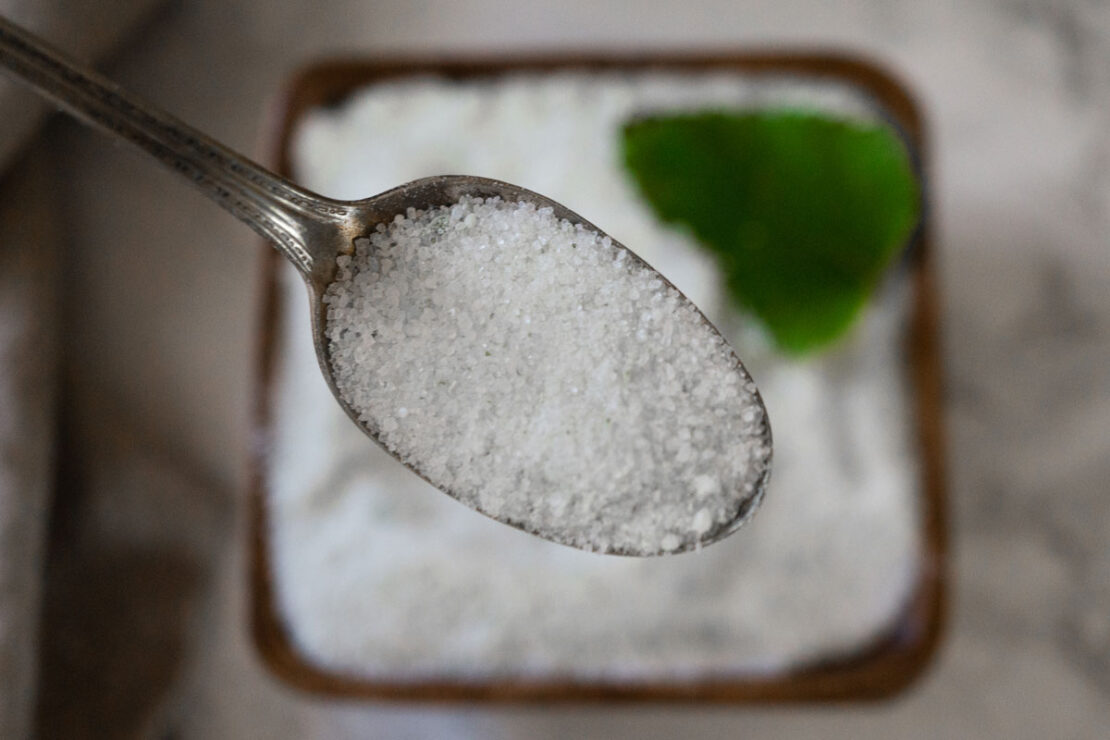
Better for Your Health: How to Leave Out the White Sugar and Use Alternative Sweeteners in Food and Herbal Preparations
The sweet flavor is a coveted one by humans, and for good reason. Throughout our history as a species, we have spent a great amount of time locating food sources. Whenever we stumbled upon juicy fruits or sweet tuberous roots, these foods equaled not only a delicious find but also our survival. The sweet flavor most commonly comes from carbohydrates, which are made up of chains of glucose molecules—the body’s preferred form of fuel. Though humans need fats and proteins for optimal health, we have historically sought out carbohydrates and their sweetness to fuel our human experience, storing away any excess for future needs. In this article, we will discuss alternative sweeteners and why they are better for your health.
Where this flavor was once harder to come by and only seasonally available in most temperate climates, modern times have changed our access to this potent fuel source and led to an overabundance of availability. Not only is the sweet flavor more readily available, but in many forms, such as cane sugar, it has been stripped of its valuable fiber. This is detrimental as fiber slows down glucose absorption and when it is removed and the resulting processed sugar consumed, blood sugar spikes, causing systemic inflammation. This can be problematic, as an excess of sugary foods consumed over the long term can lead to blood sugar dysregulation in the form of metabolic disorders such as insulin resistance and type-2 diabetes. This inflammatory process is linked to the increasingly common degenerative diseases, like cardiovascular disease, we see today (Lustig, 2021), and one reason that alternative sweeteners are a good choice.
With the growing awareness of health and the importance of diet, especially for those with blood sugar issues, finding suitable alternative sweeteners to sugar has become a focal point both in culinary and herbal preparations. Exploring various substitutes for sugar in recipes can be challenging. Knowing the flavor of a sugar substitute, how it will affect the recipe you are creating, and if it is actually good for you can be a daunting task.
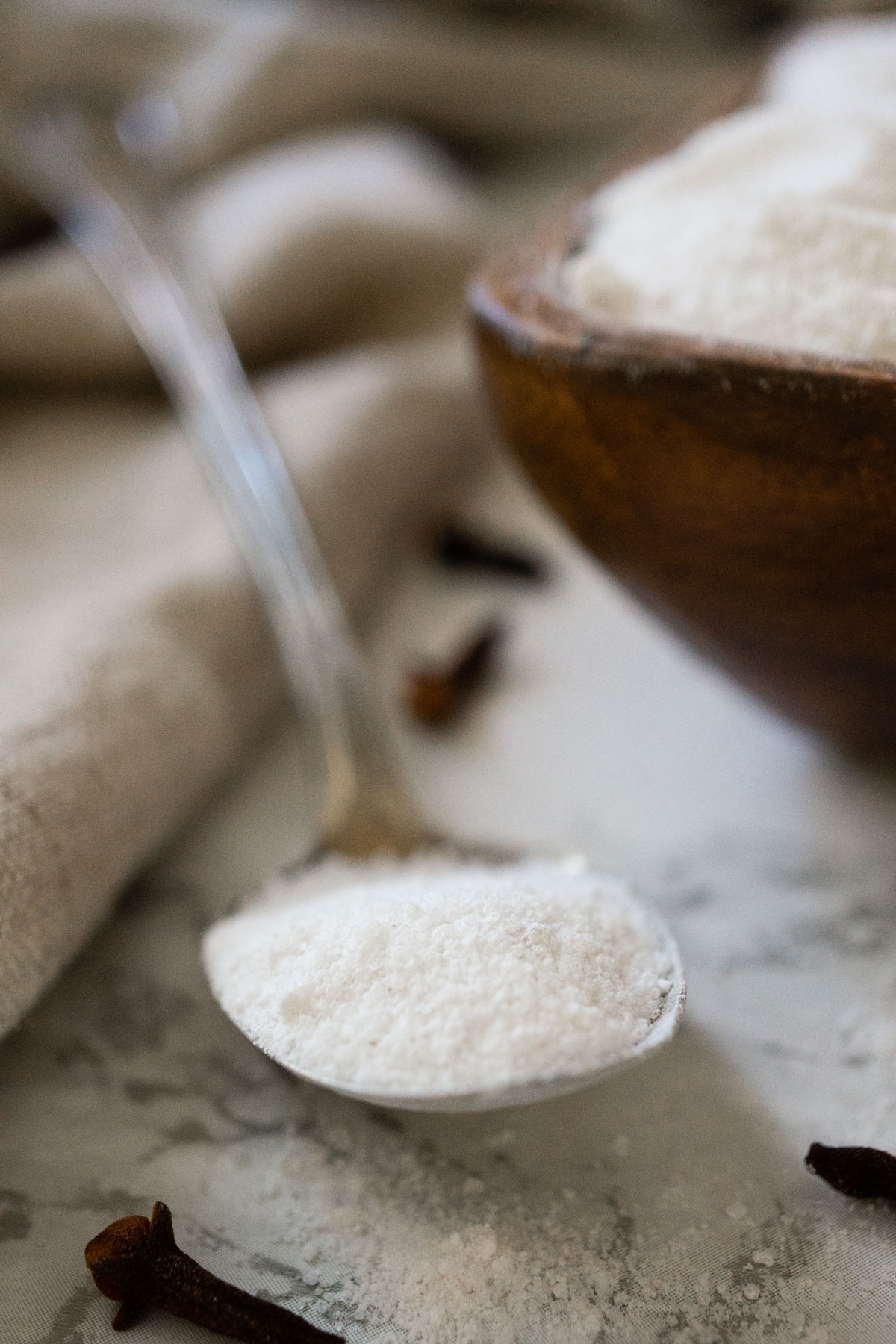
Are Any Sugars Healthy?
All carbohydrates are made up of chains of sugars; they come in various forms. Simple sugars, known as monosaccharides, are molecules you have heard of—glucose and fructose. Link these two together and you get sucrose, a disaccharide that we know as the common crystalized sugar molecule.
In a perfect world, dietary sugars would come into our bodies clothed in fiber, in whole food form, the way nature made them. Ultra-processed foods, which remove the natural fibers from grain crops like corn, wheat, and rice, repackage these plants into varying shapes, textures, and colors, alongside added sugars. These processed foods are the driver of many illnesses in Westernized societies and processed food companies are aware of how addictive sugar can be, utilizing this to their gain (Lustig, 2021).
No matter the type of natural sugar we are consuming—glucose, fructose, or sucrose—it prompts a metabolic response and the secretion of insulin. One way we measure the body’ ‘s metabolic response to foods is through the glycemic index. This is used to measure specific foods’ impact on the body’s level of blood sugar elevation post-consumption. The problem with this test is it only measures blood glucose levels and does not consider fructose, the other sweeter monosaccharide counterpart to glucose.
Fructose has a lower glycemic index due to its molecular structure, as it does not register on a blood test the same as straight glucose, but it is still readily absorbed by the body with metabolic impacts on health. Excess fructose consumption leads to a greater increase in reactive oxygen species (a type of free radical), directly stimulates fat cell production and storage, and leads to non-alcoholic fatty liver disease (Lustig, 2021).
While there are nuances between the types of sugars, in short, natural alternative sweeteners should be consumed in moderation.
The Role of Sugar in Recipes
Before delving into alternative sweeteners, it’s important to understand sugar’s role in recipes. Sugar is more than just the addition of a sweet flavoring agent. Sugar draws water into itself in a process called hygroscopy. This retains moisture in foods, particularly baked goods. The water absorption by sugar molecules decreases the amount available for microbial growth and can act as a preservative in certain preparations. This is especially important in herbal concoctions such as syrups. Luckily, some of the cane sugar substitutes have this same property.
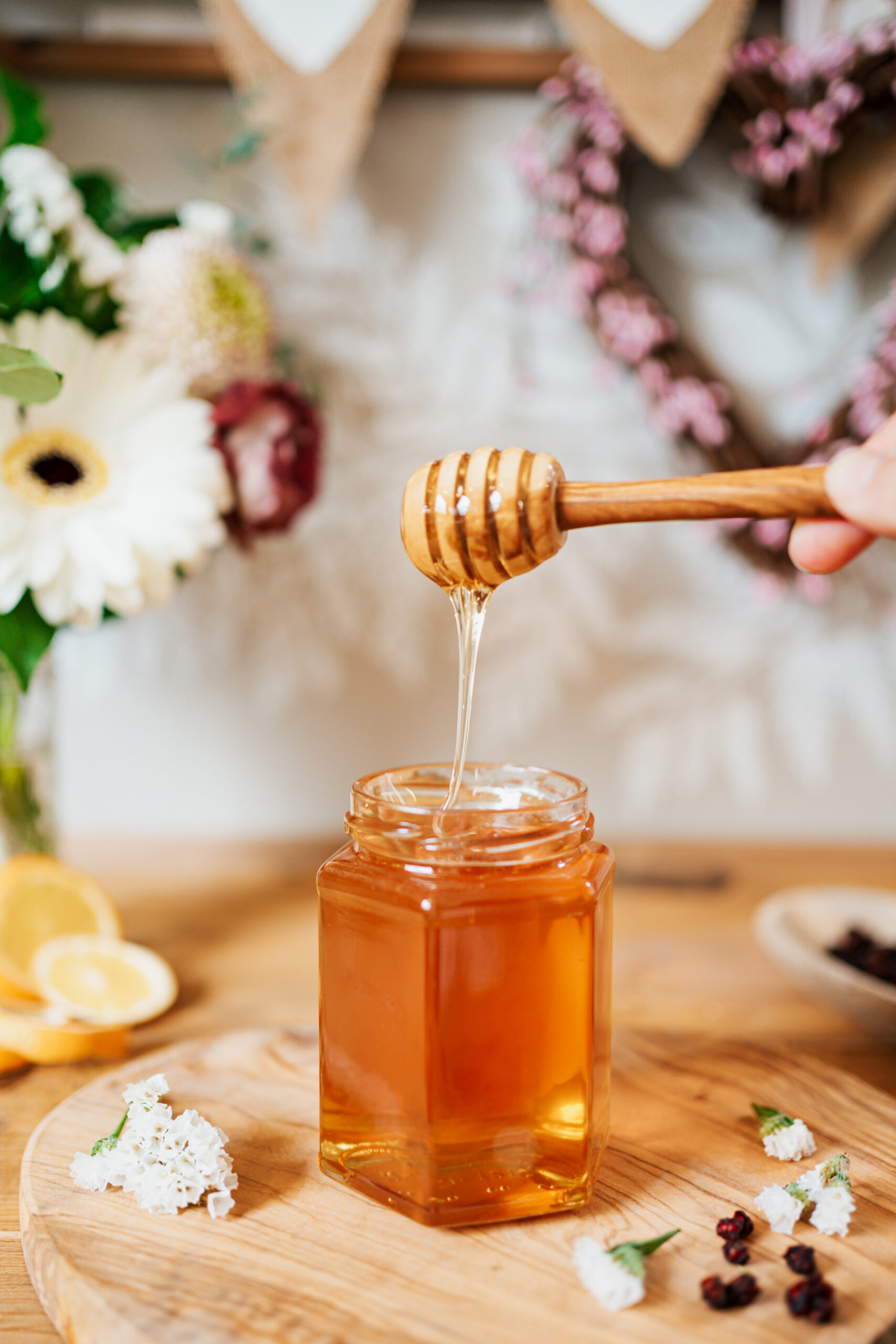
Natural Sweeteners
Nature’s common sources of simple sugars are sugarcane and sugar beets (the two main plants from which our processed sugar is derived) as well as honey, maple syrup, dates, coconuts, and agave. When we replace sugar with honey or maple syrup or even date sugar, we are not necessarily changing the molecular type of sugar we are consuming—as these are all made up of varying amounts of glucose, fructose, and sucrose.
Processed white sugar offers sweetness and calories with minimal nutritional benefits, lacking the vitamins, minerals, and antioxidants found in some of the naturally sweet counterparts, which are in some ways healthier than refined sugar, though their metabolic impact is not much different.
Honey, which is made by honeybees and a few other insects, contains trace amounts of B vitamins and minerals such as potassium (Arshad et al., 2022). Its composition can vary based on the flowers visited by the bees, offering a range of flavors and properties. Honey’s sugar content is made up of mainly glucose and fructose molecules but includes some sucrose. Honey is also hygroscopic and can be used in place of white sugar in herbal syrups at an equal ratio.
Honey is a choice substitute for white sugar in many baking recipes. When substituting honey for white sugar, use a ratio of 3/4 cup of honey for every 1 cup of sugar.
Maple syrup comes to us from the boiled sap of maple trees and is another natural sweetener with a rich flavor. It contains a greater amount of sucrose with some single molecules of fructose and glucose. It is a rich source of phenolic compounds and minerals like manganese, calcium, and zinc (Saraiva et al., 2022).
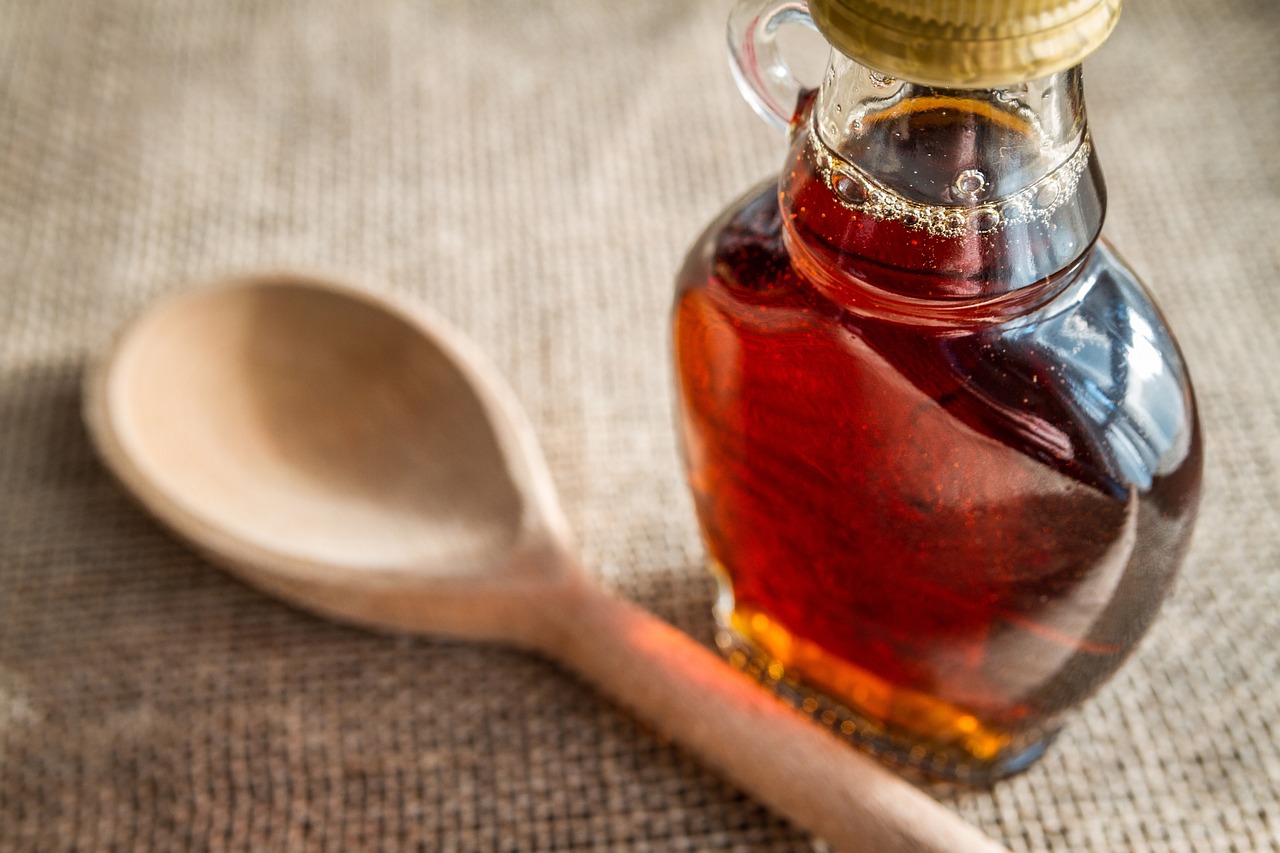
Maple syrup can replace sugar in many recipes. It’s particularly effective in baked goods and is a good sugar substitute in herbal syrups. Substitute 3/4 cup of maple syrup for every 1 cup of sugar.
Date sugar is derived from the dried fruit of the date palm (Phoenix dactylifera) with a nutritional profile that maintains a higher quantity of beneficial dietary fiber than other sugar substitutes. It also contains vitamins, minerals, and antioxidant rich proanthocyanidins (Arshad et al., 2022).
Date sugar is primarily fructose, and is slightly less sweet than white sugar, with a rich flavor that enhances baked goods and other recipes. However, it doesn’t dissolve as readily as granulated sugar due to its fiber content, so it’s best used in recipes where this more fibrous texture is acceptable.
For substitution, you can generally replace white sugar with date sugar in a 1:1 ratio in recipes that do not require sugar to dissolve completely.
Coconut sugar is another plant-derived sweetener high in sucrose that is made from the sap of coconut palm trees, and has a distinct caramel-like flavor. It is calorically equal but less processed than white sugar and retains more nutritional content such as small amounts of iron, zinc, calcium, and potassium (Arshad et al., 2022). Due to its high hygroscopicity, it can be used in place of white sugar in herbal syrups. It can be used as a 1:1 substitute in recipes and baked goods.
Agave syrup is made up of mostly fructose (Saraiva et al., 2022) and has a higher caloric density than table sugar. It is made from the sap of the agave (Agave americana) plant, and is somewhat more nutrient-dense than white sugar, as it contains some vitamins, minerals, and antioxidant polyphenols (Saraiva et al., 2022).
A potential downside to agave syrup is that it is highly processed—the application of heat during processing destroys some of its nutritional benefits. Due to its high fructose content, agave syrup is not a great option for those with metabolic dysfunction as it will spike insulin levels and have negative impacts on liver health. Yet, agave syrup can be used as a white sugar replacement. It’s about 1.5 times sweeter than sugar, so you can use less of it. Substitute agave syrup for sugar in a 1/2 to 1 ratio.
Honey, maple syrup, coconut sugar, and agave syrup impart their own unique flavor to recipes, offering more complex tastes and nutritional profiles compared to processed sugar.
All of these natural sugars have more nutrient content and are touted to have a lower glycemic index compared to processed sugar because they have a lesser amount of glucose due to their fructose content, which means they cause a slower rise in blood-glucose levels. This does not equate to a metabolically healthier alternative, though, and these should be consumed in moderation, preferably as close to their natural whole foods source as possible.
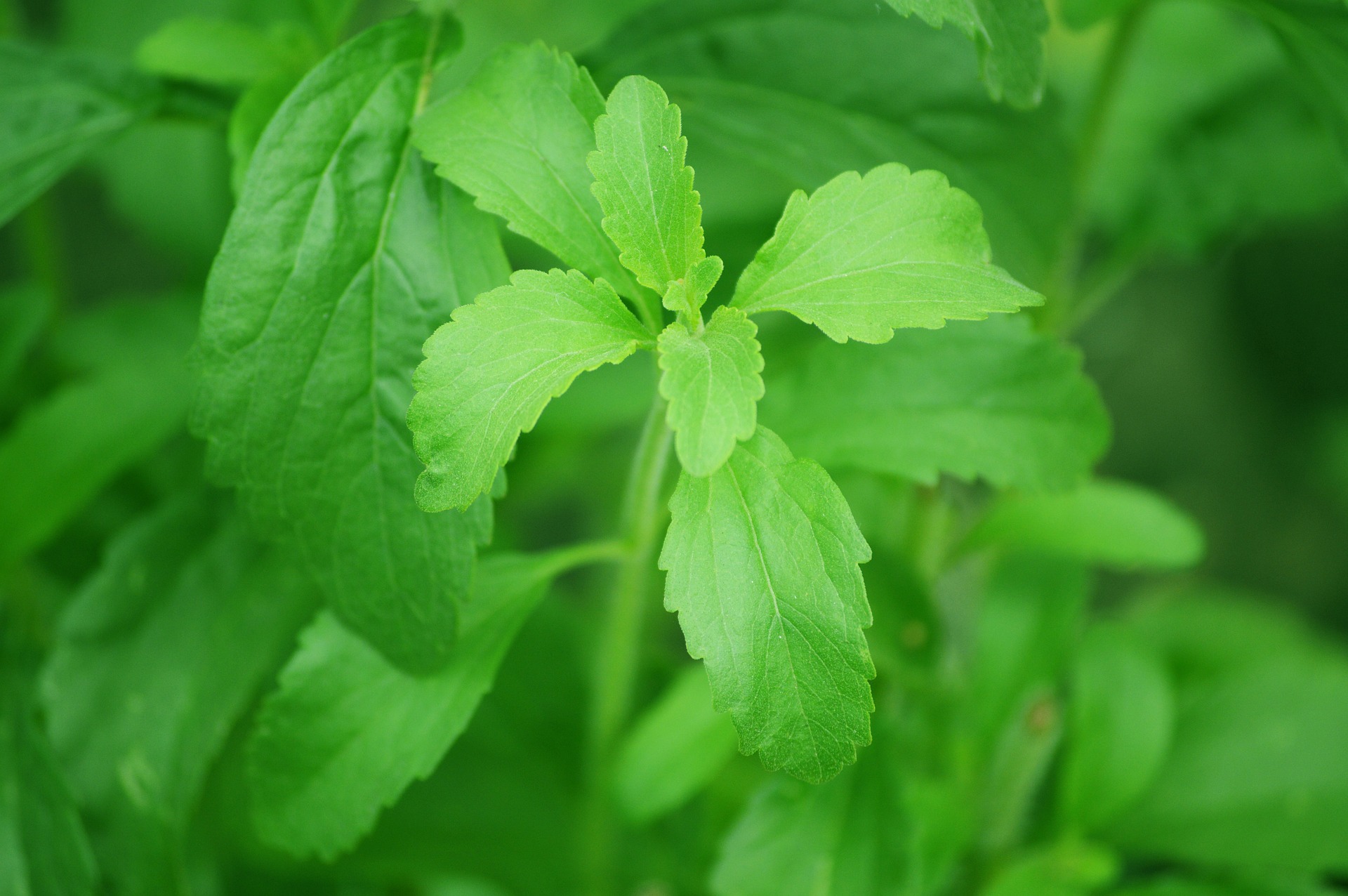
Plant-Extracted Non-Sugar Alternative Sweeteners
Plant-based alternative sweeteners are extracted from varying parts of sweet-tasting plants that do not come from carbohydrates or sugar molecules. These are often found to be non-nutritive, as they do not contain much in the way of vitamins, minerals, or calories. The most well-known non-sugar sweetener is stevia.
Commercial stevia sweeteners are derived from the leaves of the Stevia rebaudiana plant, is much sweeter than sugar (up to 300 times) and is considered a non-nutritive sweetener as it has no calories or carbohydrates (Ashwell, 2015). Stevia gets its sweet flavor from steviol glycosides (Ashwell, 2015).
The leaf of stevia can be used, either whole or powdered, as an addition to herbal concoctions such as infusions and syrups, to add a bit of sweetness to the mix. Using the plant in its whole form is beneficial, as it is less processed and contains other nutrients, such as polyphenols, found in the leaf.
Stevia extract can be purchased in liquid and powdered forms and is a healthier option for those who have blood sugar imbalances, although it can have a bitter aftertaste.
Culinarily, you can use approximately 1 teaspoon of powdered stevia or a few drops of liquid stevia to replace 1 cup of sugar—a little goes a long way. Stevia extract could be used in herbal syrups as it is hygroscopic, but it is not a popular choice as you would need a large amount to reach shelf stability, and the end result would be extremely sweet. Instead, consider using stevia as an additive to teas, infusions, or decoctions for an added sweet flavor.
Another alternative sweetener commonly seen on store shelves is the plant-based sweetener monk fruit.
Monk fruit sweetener, created from a water extraction process of the fruit of Siraitia grosvenorii (Younes et al., 2019) a plant in the Cucurbitaceae (gourd) family. Monk fruit comes in a powdered or liquid form and is another calorie-free option. It’s sweeter than sugar and doesn’t raise blood sugar levels, getting its sweetness from glycosides called mogrosides (Younes et al., 2019).
You can substitute monk fruit extract sweetener in powdered form at a 1:1 ratio or less as a replacement for sugar in culinary recipes. The extract can be used to sweeten herbal infusions and decoctions, but it is not commonly seen used for herbal syrups.
Monk fruit extract is generally recognized as safe, and approved for us in many countries, including the United States, but has yet to be approved in Europe as a food additive due to the need for further research studies.
Though these plant-extracted, non-nutritive sweeteners do not contain sugar molecules adding directly to an elevation in blood sugar, research shows these plant-based sweeteners, as well as the sugar alcohols and artificial sweeteners, have the potential to increase food intake during meals which raised overall insulin release post meals, though not as much as natural sugars (Tey et al., 2017).
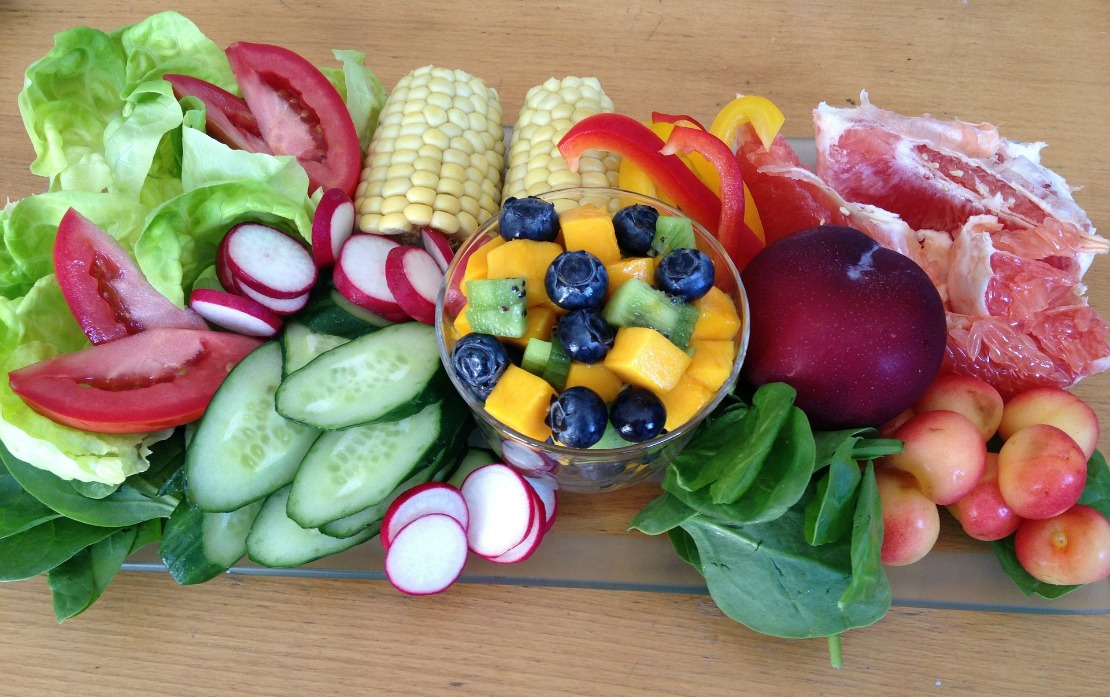
Sugar Alcohols as Sugar Substitutes
Sugar alcohols, also known as polyols, are a type of hybrid carbohydrate that is produced through a fermentation process from natural sources—fruits and vegetables. They resemble sugar in taste and texture but with fewer calories. Common sugar alcohols include xylitol and erythritol. They are frequently used in sugar-free and low-carb products like chewing gums, candies, ice cream, and baked goods.
Erythritol is a sugar alcohol that has a similar taste and texture to sugar, making it a one-to-one substitute in many baked goods and other recipes. Erythritol is about 60% to 80% as sweet as sugar and has almost no calories. It has a glycemic index of zero, meaning it does not spike blood sugar, as it moves out of the body quickly and does not have a chance to be metabolized, which is beneficial for those managing diabetes. Erythritol is often mixed with other alternative sweeteners to enhance its sweetness and is used in a variety of sugar-free products. It can be used in your home kitchen while creating herbal culinary dishes or added to teas as a low-calorie sweetener.
It is important to note that erythritol has been studied for its potential to increase the risk of cardiovascular diseases due to an elevation in blood clotting (Witkowski et al., 2023).
Xylitol is another sugar alcohol with an equal level of sweetness to sucrose and has a slow metabolic impact; it is touted for its dental benefits and has some efficacy as an antimicrobial (Salli et al., 2019). It can be used in baking, and substituted in a 1:1 ratio for sugar. Xylitol is poisonous to dogs in very small amounts; it is important to be mindful of this sugar alcohol, and any products it contains, around dogs.
While sugar alcohols may be a healthier choice for blood sugar regulation, they come with their own set of potential downfalls and should be researched before use. Another negative side effect of sugar alcohols is they can cause digestive issues, especially when consumed in large amounts, due to their incomplete absorption in the small intestine, leading to fermentation in the large intestine; common side effects include bloating, gas, and diarrhea (Mäkinen, 2016). Individuals with sensitive digestive systems or those with digestive disorders may need to be particularly cautious.
A Note on Artificial Sweeteners
Chemical sweeteners, commonly referred to as artificial sweeteners, are synthetic sugar substitutes often used to provide sweetness without the added calories of natural sugars. These sweeteners are much sweeter than sugar and are used in a variety of products, including beverages, baked goods, and as tabletop sweeteners. Some of the most well-known chemical sweeteners are aspartame and sucralose potassium.
Aspartame is a chemical sweetener commonly found in diet sodas, sugar-free gum, and low-calorie desserts. Aspartame is made from two amino acids, aspartate and tryptophan (Iizuka, 2022). Reports have suggested potential side effects include headaches, dizziness, and digestive issues.
Sucralose is a synthetic sweetener known under the brand name Splenda. It is unique among artificial sweeteners in that it is derived from sugar through a process that replaces three hydroxyl groups in the sugar molecule with chlorine atoms (Grotz & Munro, 2009). It is 600 times sweeter than sucrose (Iizuka, 2022). Some studies have raised concerns about its potential impact on gut health and glucose metabolism.
While these are generally recognized as safe by regulatory agencies like the FDA, studies have raised concerns showing a link between high intake of artificial sweeteners and increased all-cause mortality, cardiovascular disease and cancer risk (Iizuka, 2022). It’s important to be informed about these sweeteners.
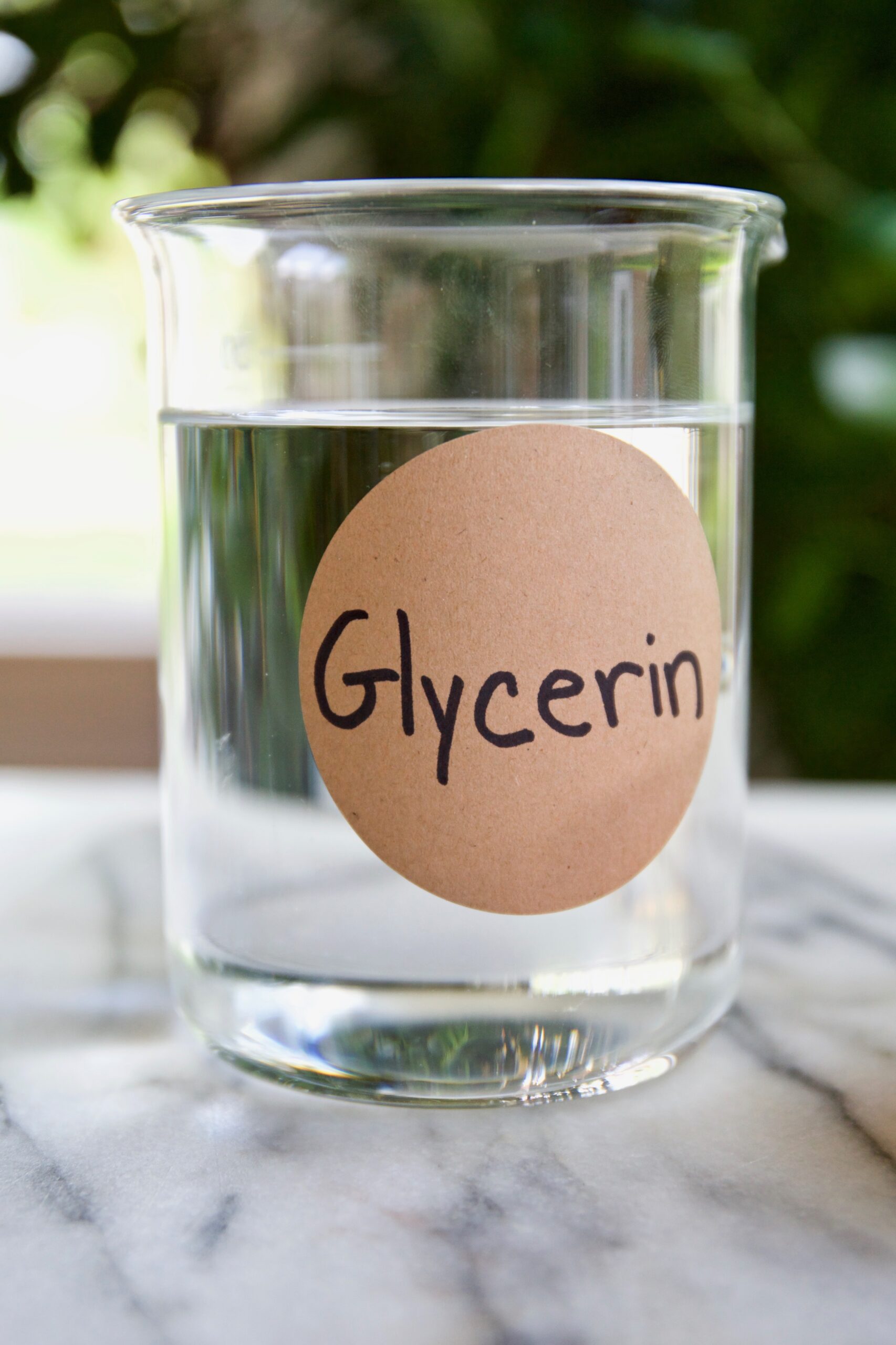
Glycerin as an Alternative for Blood Sugar Management
If you are looking for a sugar substitute for blood sugar management, glycerin, also known as glycerol, is a viable option. It is a clear, odorless liquid most commonly derived from plant oils. It doesn’t spike blood sugar levels, making it more suitable for people with diabetes or insulin resistance. Though it is important to note it has little nutritional value.
Glycerin is used as a menstruum in tincture making for those avoiding alcohol, or who are desirous of a sweeter taste in their plant extracts. Glycerin is an effective preservative when used above 55% in a recipe.
In recipes, glycerin provides a sweet taste and helps in retaining moisture. It can be used as a sugar replacement in a 1:1 ratio, though as a liquid this may affect the recipe’s moisture content.
Incorporating Alternative Sweeteners into Herbal Syrups
Herbal preparations, such as syrups, often use white sugar as a base for extraction and preservation. Substituting sugar with natural alternatives and other alternative sweeteners can easily be done.
When making herbal syrups, you can consider replacing sugar with glycerin, honey, coconut sugar, or maple syrup in a 1:1 ratio to replace sugar in herbal syrups. Due to the high sugar content in these white sugar alternatives, they all have a hygroscopic nature and can be used as a preservative similarly to sugar but the shelf life will vary depending on the final sugar content of the prepared syrup. Keeping in the refrigerator helps to extend shelf life.
One other interesting alternative used in herbalism for making syrups is blackstrap molasses. It is a thick, dark syrup produced as a byproduct of the sugar-making process. It’s derived from refining sugarcane or sugar beets into sugar. It has a distinct flavor, from sweet to slightly bitter, and comes in varying types.
Blackstrap is the darkest molasses in coloring and has the highest nutritional content—rich in vitamins and minerals such as iron, calcium, magnesium, and vitamin B6. Molasses is commonly used culinarily and is a key ingredient in recipes like gingerbread, baked beans, and barbecue sauces.
In herbalism, you may see recipes calling for molasses used to create an herbal syrup, particularly when addressing iron deficiency. It is traditionally used to extract yellow dock (Rumex crispus) root for this purpose. When used to extract dried herbs, molasses will remain shelf stable for 6 months.
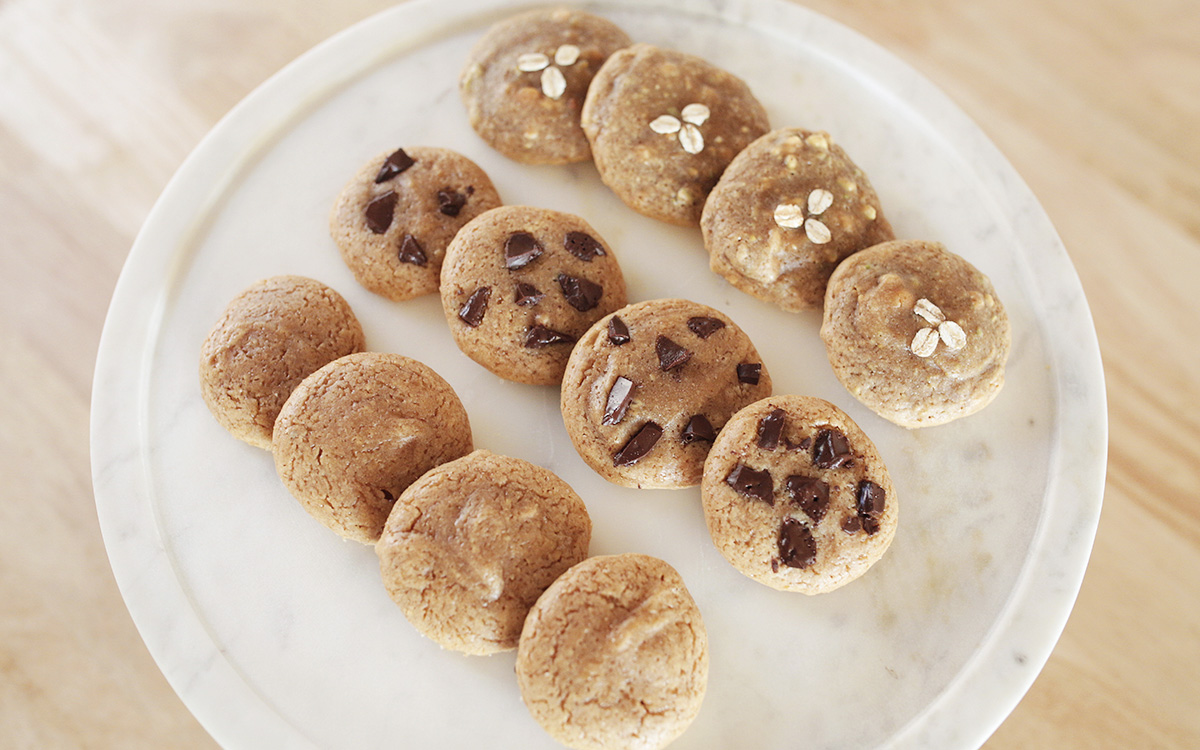
Tips for Substituting White Sugar in Herbal Foods and Baked Goods
Experiment in Small Batches: When trying out a new alternative sweetener, start with small batches to see how it affects the flavor and texture of your recipe.
Adjust Ratios: Different alternative sweeteners have varying sweetness levels. Adjust the quantity used in recipes accordingly to achieve the desired level of sweetness.
Consider Texture and Moisture: Sugar plays a role in the texture and moisture of baked goods. Be mindful of how your chosen alternative sweetener may impact these factors and adjust other ingredients as needed.
Be Mindful of Temperature: Some alternative sweeteners, like stevia, may have an altered taste when exposed to high temperatures. Consider the cooking or baking temperature of your recipe and choose a sweetener that can withstand it.
In Closing,
Substituting white sugar in baked goods, food recipes, and herbal preparations can be a healthy choice. For those managing blood sugar levels, there are viable alternative sweeteners with a lower metabolic impact. You can create delicious, sweet treats and herbal preparations without compromising on flavor or your health. Remember, the key is to experiment and find what works best for your specific needs and tastes. With the right approach, the end result can be both satisfying and beneficial.
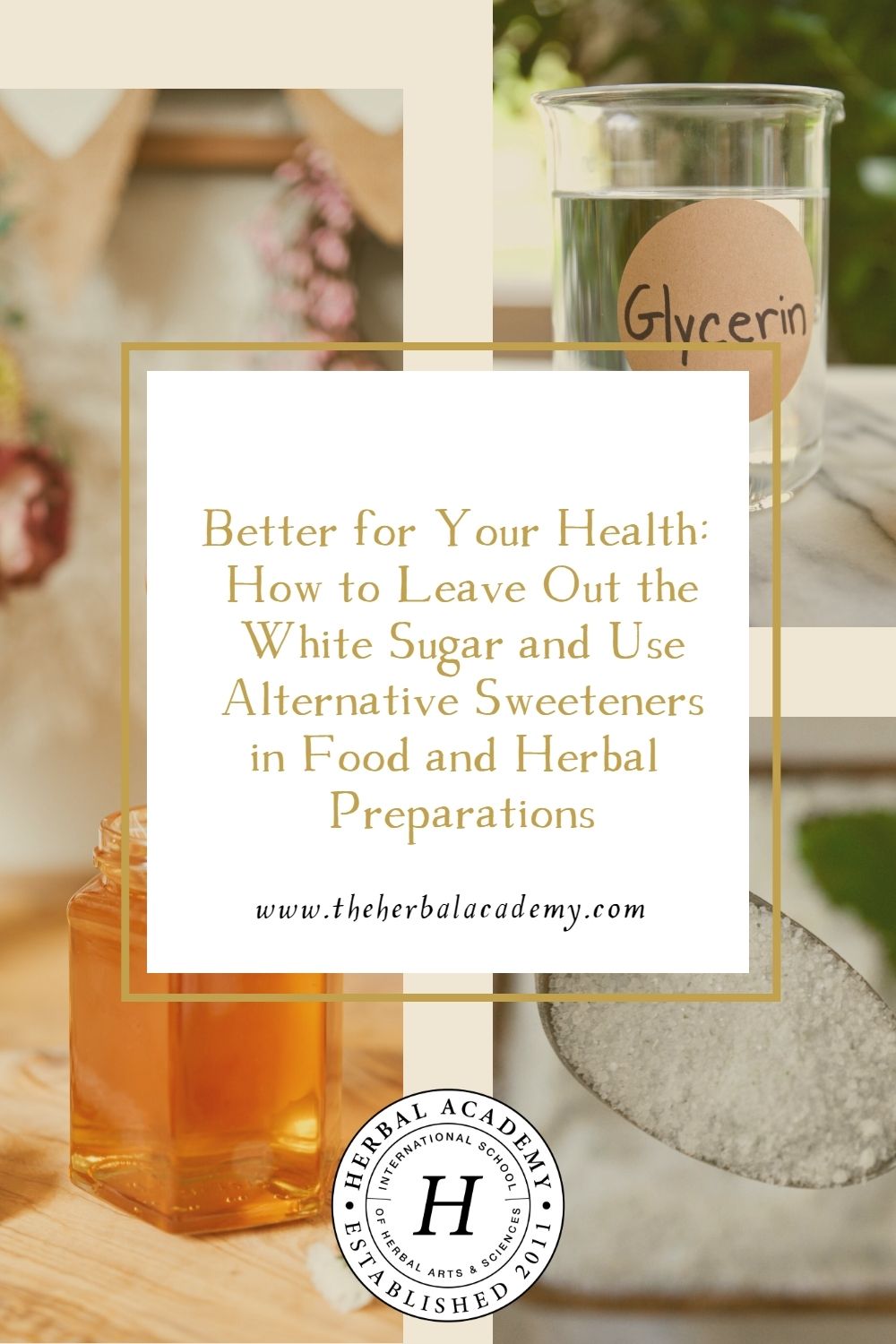
REFERENCES
Arshad, S., Rehman, T., Saif, S., Rajoka, M.S.R., Ranjha, M.M.A.N., Hassoun, A., … Aadil, R. M. (2022). Replacement of refined sugar by natural sweeteners: Focus on potential health benefits. Heliyon, 8(9), e10711. https://doi.org/10.1016/j.heliyon.2022.e10711
Ashwell M. (2015). Stevia, nature’s zero-calorie sustainable sweetener: A new player in the fight against obesity. Nutrition Today, 50(3), 129–134. https://doi.org/10.1097/NT.0000000000000094
Grotz, V.L., & Munro, I.C. (2009). An overview of the safety of sucralose. Regulatory Toxicology and Pharmacology, 55(1), 1–5. https://doi.org/10.1016/j.yrtph.2009.05.011
Iizuka K. (2022). Is the use of artificial sweeteners beneficial for patients with diabetes mellitus? The advantages and disadvantages of artificial sweeteners. Nutrients, 14(21), 4446. https://doi.org/10.3390/nu14214446
Lustig, R.H. (2021). Metabolical: The lure and the lies of processed food, nutrition, and modern medicine. Harperwave.
Madlala, H.P., Maarman, G.J., & Ojuka, E. (2016). Uric acid and transforming growth factor in fructose-induced production of reactive oxygen species in skeletal muscle. Nutrition Reviews, 74(4), 259–266. https://doi.org/10.1093/nutrit/nuv111
Mäkinen K.K. (2016). Gastrointestinal disturbances associated with the consumption of sugar alcohols with special consideration of xylitol: Scientific review and instructions for dentists and other health-care professionals. International Journal of Dentistry, 5967907. https://doi.org/10.1155/2016/5967907
Salli, K., Lehtinen, M.J., Tiihonen, K., & Ouwehand, A.C. (2019). Xylitol’s health benefits beyond dental health: A comprehensive review. Nutrients, 11(8), 1813. https://doi.org/10.3390/nu11081813
Saraiva, A., Carrascosa, C., Ramos, F., Raheem, D., Lopes, M., & Raposo, A. (2022). Maple syrup: Chemical analysis and nutritional profile, health impacts, safety and quality control, and food industry applications. International Journal of Environmental Research and Public Health, 19(20), 13684. https://doi.org/10.3390/ijerph192013684
Tey, S., Salleh, N., Henry, J. & Forde, C.G.. (2017). Effects of aspartame-, monk fruit-, stevia- and sucrose-sweetened beverages on postprandial glucose, insulin and energy intake. International Journal of Obesity, 41, 450–457. https://doi.org/10.1038/ijo.2016.225
Witkowski, M., Nemet, I., Alamri, H., Wilcox, J., Gupta, N., Nimer, N., … Hazen, S.L. (2023). The artificial sweetener erythritol and cardiovascular event risk. Nature Medicine, 29, 710-718. https://doi.org/10.1038/s41591-023-02223-9
Younes, M., Aquilina, G., Engel, K.H., Fowler, P., Frutos Fernandez, M.J., Fürst, P., … & Castle, L. (2019). Safety of use of monk fruit extract as a food additive in different food categories. EFSA Journal, 17(12), e05921. https://doi.org/10.2903/j.efsa.2019.5921







